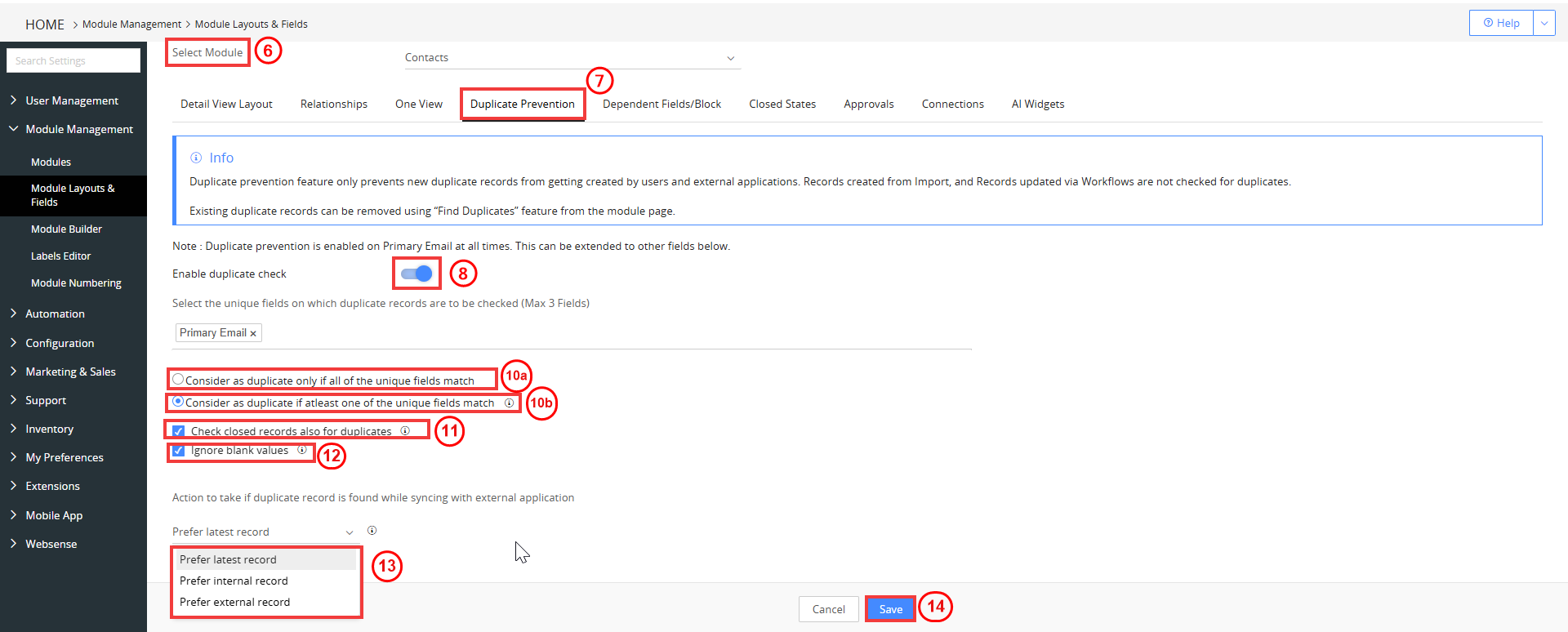Articles in this section
Duplicate Prevention in Modules
Feature Availability
Vtiger Editions: One Pilot | One Growth | One Professional | One Enterprise | One AI
Introduction
Maintaining clean and reliable data is essential for any CRM system. In Vtiger CRM, Duplicate Prevention helps ensure data integrity by stopping the creation of duplicate records within the same module. A duplicate record contains the same key information—such as email, phone number, or name—as another record in that module, leading to confusion and data redundancy.
This feature allows you to define up to three fields to check for duplicates when a new record is created, whether manually, through Imports, Webforms, Workflows, or external integrations. Duplicate prevention is module-specific, so the same value can exist in other modules unless configured separately. By enabling this, you can maintain accurate data, reduce clutter, and improve CRM efficiency.
Note: If you already have duplicate records in the CRM, there is a way you can find them and eliminate them. To know more about finding duplicates, click here.
Sources of Duplicate Records
Duplicate records can be introduced into your CRM through various actions and features. Common sources include:
- Creating, importing, or performing a mass edit on records
- Adding records using the Quick Create option
- Automated processes such as Mailroom, Webforms, Workflows, and the Chrome Plugin
By enabling duplicate prevention, the system automatically checks and blocks duplicates from being created through these processes.
Benefits of Duplicate Prevention
The following are the benefits of Duplicate Prevention in CRM:
- Ensures Data Accuracy: Prevents inconsistent or repeated information from entering the CRM.
- Saves Time and Effort: Reduces manual clean-up and avoids confusion caused by redundant records.
- Improves Reporting and Analytics: Clean data leads to more accurate dashboards and insights.
- Enhances Workflow Efficiency: Automated processes rely on unique data; duplicates can disrupt automation.
In this article, you will learn about:
- Setting up Duplicate Prevention
Setting up Duplicate Prevention
By setting up duplicate prevention, you can prevent users and external applications from creating duplicate records in a module.
Note: Only Admin users can access and set up the duplicate prevention settings.
Follow these steps to set up duplicate prevention for a module:
- Log in to the CRM.
- Click the User Menu on the top-right corner of the screen.
- Click Settings. The Settings page opens.
- Go to Module Management.
- Select Module Layouts & Fields. The Module Layouts & Fields page opens.

- Select the module for which you want to set up duplicate prevention from the Select Module drop-down.
- Click the Duplicate Prevention tab.
- Turn on the Enable duplicate check toggle button.
- Select the fields (maximum three) based on which you want to run the duplicate check.
- For example, in the Deals module, if you select Deal Name, users will not be able to create a new Deal with the same name as an existing Deal.
- Enable either of the following settings:
- Consider as duplicate only if all of the unique fields match - A record is considered a duplicate if all the fields defined match.
- Consider as duplicate if at least one of the unique fields matches - A record is considered a duplicate if at least one of the defined fields matches.
- Enable Check closed records also for duplicates to run the duplicate check on closed records. Disable it to ignore closed records while checking for duplicates.
- Enable Ignore blank values to avoid searching for duplicates on empty field names. Disable it otherwise.
- Choose an action to take if a duplicate record is found while syncing with an external application.
- Prefer latest record - The most recently modified record (CRM or external) will be retained.
- Prefer internal record - The record existing in the CRM will be retained.
- Prefer external record - The record in the external application will be copied and retained.
- Click Save.
Limitations
Below are the key limitations of Duplicate Prevention in Modules:
- Import: The fields selected for duplicate prevention in Module Layouts & Fields are not considered during data imports. You must manually define duplicate handling fields during the import step.
- Workflows: Actions that update fields through workflows do not perform duplicate checks, even if those fields are enabled for duplicate prevention.
- Schedulers: Records created or modified through scheduler-based automation are not validated against duplicate prevention rules.
- Other Features (e.g., Recurring Invoices, Subscriptions, MailScanner): These features can prevent duplicate records from being created, but they do not notify the user when a duplicate is skipped.
References
Finding Duplicate Record
Importing Data
Module Layouts and Fields